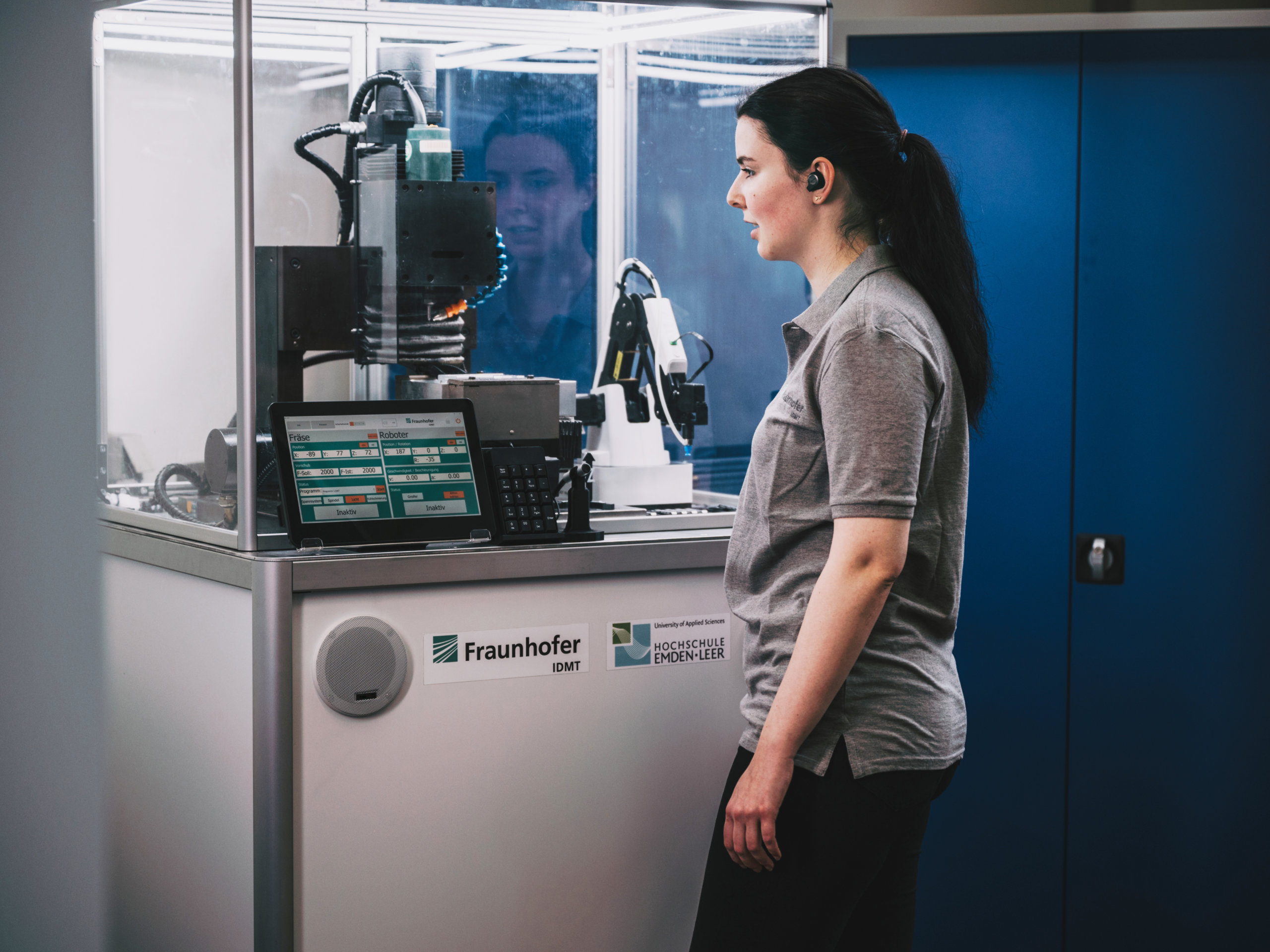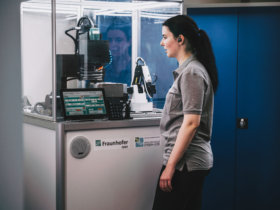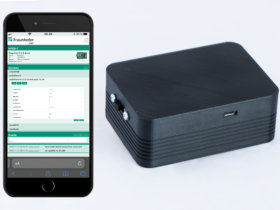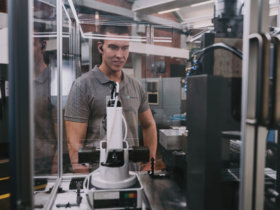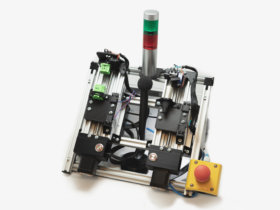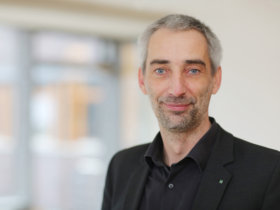Digital factories are learning to listen
Round table discussion with representatives of the “Audio technology for intelligent production” industry working group
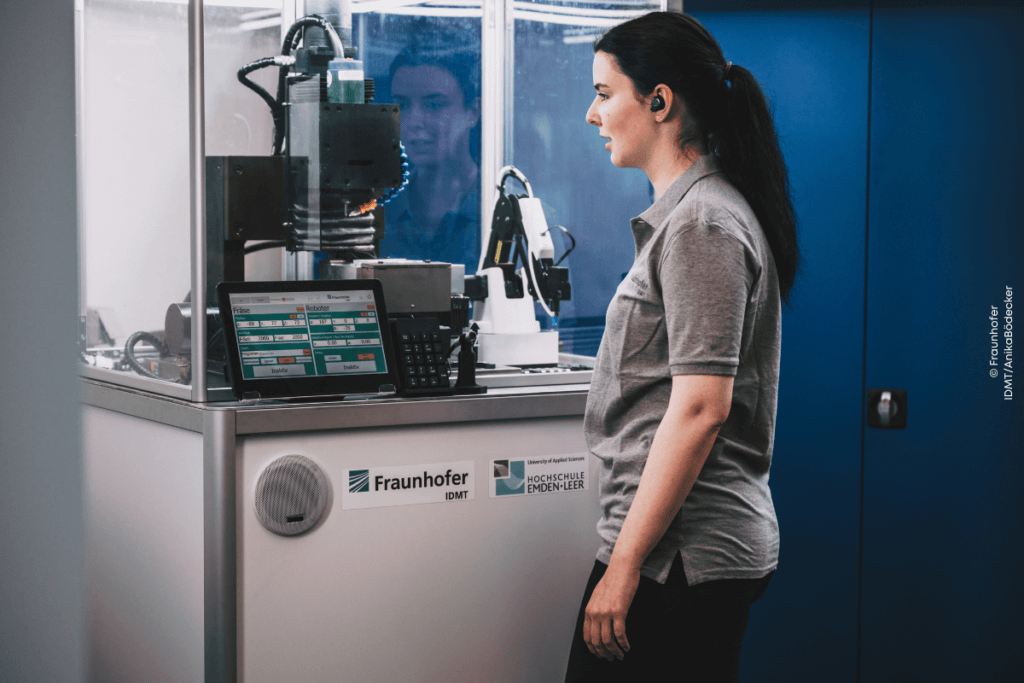
Why are smart microphones being used in factories? Are companies planning to eavesdrop on their workforce? A clear “no” is the answer to the latter question from the “Audio Technology for Intelligent Production” (AiP) industry working group, founded in 2020 at the Oldenburg site of the Fraunhofer Institute for Digital Media Technology IDMT in cooperation with the Emden/Leer University of Applied Sciences. The network explores how machines interact with acoustic systems and AI. Five scientists and an engineering service provider explain why audio technology is being featured as a future topic at EMO Hannover 2023.
Dr. Appell, why are experts from the automotive, aviation, engineering, electronics and other industries working together with researchers like you in the AiP industry working group?
Dr. Jens Appell, Head of the Department of Hearing, Speech and Audio Technology at the Oldenburg Branch of the Fraunhofer IDMT: We have joined forces to exploit the wide-ranging potential of audio technology in digitalized production and assembly. Together with our industrial partners we are developing application scenarios, discussing their design and putting them into practice in joint projects.
Professor Lange, there is nothing new about using microphones within production – for condition monitoring, for example. So what innovative potential does audio technology hold, exactly?
Prof. Dr.-Ing. Sven Carsten Lange, Professor of Production Technology at the Emden/Leer University of Applied Sciences and Scientific Advisor at Fraunhofer IDMT in Oldenburg in the field of Hearing, Speech and Neurotechnology for Production: Acoustic process monitoring has actually been around for some time. However, we are breaking new ground in wide-ranging multimodal applications for diagnosing process characteristics and production processes in parallel and in real time with a sensor, or in characterizing machines in terms of their machining status and process capability, or even in operating them directly using voice commands. And none of this involves any significant effort or costs for integration in new and existing machines.
Mr. Arnold, can you give us your assessment as a long-standing system integrator from the industry? To what extent is this new territory?
Lorenz Arnold, Managing Director, MGA Ingenieurdienstleistungen GmbH, Process Automation and Control Technology, Würzburg: Acoustic technology is already being used in production for condition monitoring, but it is not yet fully established. A prime example of new territory here is speech-based human-machine interaction, which has so far only been used in experimental and niche applications in industrial production. The activities of the AiP working group are thus leading the way worldwide. I’m not aware of any competitors in this field, either nationally or internationally, at present.
Mr. Norda, you coordinate the AiP working group. What distinguishes your form of voice control from other systems such as Siri or Alexa, and what makes it a global leader?
Marvin Norda, working group coordinator at Fraunhofer IDMT, Oldenburg: The requirements on the factory floor are quite different from those in the living room. What is needed here is an acoustic system that requires no external servers, that runs only on company computers and functions reliably even under difficult production conditions, including noise interference. We develop application-specific voice control solutions for use in production which are robust and intuitive. Voice control is easy to integrate and works even without an Internet connection. It is good at recognizing voice commands even under the challenging acoustic conditions found in industrial production.
How do you convince prospective industrial customers about your form of voice control?
Marvin Norda: By showing how it works on a voice-controlled production cell. We have a 5-axis milling machine and a 4-axis robot, both fully equipped with voice control. This technology platform allows customers to test various microphones, headsets and voice commands in a range of different noise environments. We’ve discovered that testing the voice control in an actual machine environment is the fastest way of convincing our industry partners.
Why is your voice control system particularly suitable for use in industry?
Marvin Norda: The extensive customization and integration support provided by Fraunhofer IDMT allows the speech recognizers to be individually adapted to specific speech commands and machine interfaces. This increases the effectiveness of the voice control and reduces the costs and effort required for integration.
What are the arguments in favor of voice control?
Marvin Norda: There are many. Speech is the most natural form of communication. That’s why we’re convinced that speech will also establish itself in industry as a communication interface between humans and machines – similar to smart home or automobile applications. In the industry working group, we are developing a basis for the operating interfaces of the next generation of industrial controllers. This basis will enable contactless and intuitive operation of multiple, complex machines.
But how do they cope with the different types of noise found in production?
Marvin Norda: We are currently putting our system to the test by evaluating a speech recognition study with over 160,000 spoken voice commands in different noise environments. As a general rule, it’s not the type of noise that is decisive, but the noise level in relation to the volume of the speaker at the point where the sound reaches the microphone. These kinds of research studies allow us to optimize our speech recognizer for use in industry and to make recommendations about acoustic systems – and the best positions for them in the workplace.
But control manufacturers are also experimenting with voice control, aren’t they?
Marvin Norda: The idea isn’t new and many control manufacturers have already put forward their own solutions. However, there has been little or no widespread industrialization of voice control so far. Our aim is to optimize efficiency and robustness levels by consistently refining our speech recognizers for use in future production environments.
Which manufacturer did you work with to create the automated production line?
Marvin Norda: We have successfully integrated our algorithms in a Beckhoff industrial controller based on a Windows or Linux platform. We are also developing similar solutions for all other well-known control manufacturers.
So your speech recognition software is not running from the cloud or on a separate PC, but on the controller in the machine itself. Is it possible to operate multiple machines by voice control?
Marvin Norda: Multi-machine operation is the pinnacle of voice control because of the complexity of the machine commands, the walking distances to the machines, and the cognitive demands placed on the operator. Acoustically, however, there is no difference between operating just one or several machines simultaneously. Just like with a touchscreen, all you need is a master computer which routes the commands to the right machine.
Lorenz Arnold: For me, multi-machine operation as an ideal application for proving that voice operation is not merely a technical gimmick. The result is a quantifiable increase in efficiency that can be quite considerable depending on the application. I’ll give you an example from my current work: A customer owns 25 machine tools, with five operators handling them. I’m now trying to convince them to use voice control. One benefit would be shorter distances, because an operator can control a machine via a headset even when standing some distance away at another machine. And the machine will tell him remotely if there is a malfunction.
What other types of added value do acoustics offer?
Sven Lange: Our acoustic systems are competing with established technology. Structure-borne sound sensors integrated into the machine for the detection of chatter noise, for example, represent state-of-the-art technology. However, these sensors cannot record other, equally relevant process and machine status information. A microphone, on the other hand, installed in a suitable position in or around the machining area can simultaneously monitor the main spindle bearing, the fan and the cooling lubricant supply, perform touch detection and record voice commands. The user value rises exponentially when our smart sensor technology is enhanced with AI-based algorithms.
Mr. Hollosi, you and your team are developing smart sensors. What tasks are they already performing?
Danilo Hollosi, Head of Acoustic Event Detection at Fraunhofer IDMT: Our acoustic process monitoring is contactless and works with airborne or structure-borne sound. The smart sensor system can detect the clicking sound when plug connections engage. If there is no click, the acoustic monitoring system registers an error. The operator is informed, too, and the event is automatically documented. My team and I have developed AI-based algorithms for reliable audio analysis of all kinds of click sounds. Our solution has already proven itself in trials on the assembly of cable harnesses in the automotive industry.
The results and work of the AiP working group represent good examples of the event’s new claim: “Innovate Manufacturing.”. The VDW is using this to attract experts from all over the world to EMO Hannover from 18 to 23 September 2023. Surely it would be an ideal opportunity for you to present your solutions at the “World’s leading trade fair for production technology”?
Christian Colmer, Head of Marketing and PR, HSA Branch, Fraunhofer IDMT: Representatives from our institute and from the working group’s partner companies will definitely be there in Hanover to hold in-depth discussions on acoustics with customers, and to sound out new application scenarios.
((Info box))
AiP Industry Working Group
More than 50 companies are working closely together in the Audio Technology for Intelligent Production AiP industry working group. It was founded in 2020 and is spearheaded by the Oldenburg Branch for Hearing, Speech and Audio Technology of the Fraunhofer IDMT, and the Emden/Leer University of Applied Sciences. Companies ranging from small SMEs to major corporations and from a wide variety of sectors – producing aircraft, cars, machinery and electronics, for example – are collaborating in the network. The common denominator is that they are all developing solutions in the following four areas: Condition monitoring, Hearing and speech technology support, Acoustic services and Workplace 4.0. The focus is on solving problems based on concrete use cases.
(Length: around 11,000 characters including spaces)
Author: Nikolaus Fecht, specialist journalist, Gelsenkirchen
Background
EMO Hannover 2023 – the world’s leading trade fair for production technology
From September 18 to 23, 2023, EMO Hannover 2023 will be the venue for international manufacturers of production technology to present their smart technologies over the whole value chain. Under the banner Innovate Manufacturing., the world’s leading trade fair for production technology will be presenting the whole bandwidth of modern metalworking, which is at the heart of all industrial production. The presentations will include the latest machines plus their efficient engineering solutions, product-related services, sustainability in production, and much, much more. EMO Hannover focuses on cutting and forming machine tools, manufacturing systems, precision tools, automated material flows, IT, industrial electronics, and accessories. Trade visitors to EMO come from all of the key industrial segments, including machine and plant building, automotive and its suppliers, aerospace, precision mechanics and optics, shipbuilding, medical engineering, tool and mold making, and steel and lightweight engineering. EMO Hannover is the most important international meet for the world’s industry. At EMO Hannover 2019, more than 2,200 exhibitors from 47 countries attracted nearly 120,000 trade visitors from about 150 countries. EMO is a registered trademark of the European machine tool association Cecimo. EMO host is the German Machine Tool Builders’ Association (VDW) of Frankfurt am Main, Germany.
Contact
Fraunhofer Institute for Digital Media Technology IDMT
Christian Colmer
Head of Marketing and Communication Oldenburg Branch for Hearing, Speech and Audio Technology HSA
Marie-Curie-Straße 2
26129 Oldenburg
Germany
Tel. +49 441 2172-436
christian.colmer@idtm.fraunhofer.de
www.idtm.fraunhofer.de
MGA Ingenieurdienstleistungen GmbH
Lorenz Arnold
Managing Director
Sanderglacisstraße 9a
97072 Würzburg
Germany
Tel. +49 93132258-0
info@mga-gmbh.com
www.mga-gmbh.com
Press Agency Dipl.-Ing. Nikolaus Fecht
Technik-Texte à la carte – wenn Ihnen die Worte fehlen
Nikolaus Fecht
Husemannstraße 29
45879 Gelsenkirchen
Germany
Tel. +49209-26575
nfecht@presseagentur-fecht.de
https://www.torial.com/nikolaus.fecht


